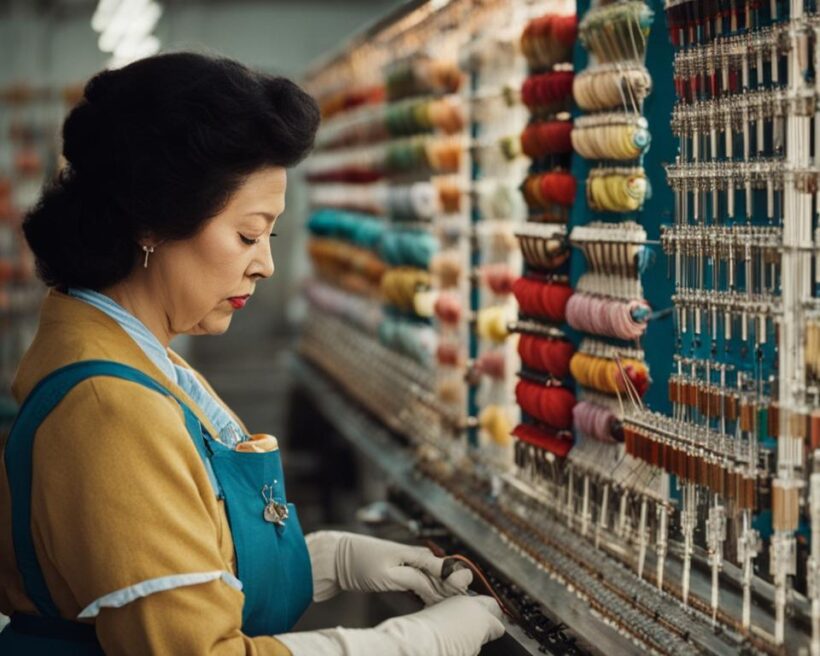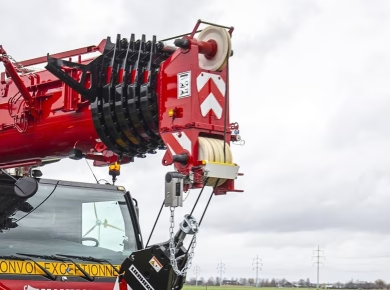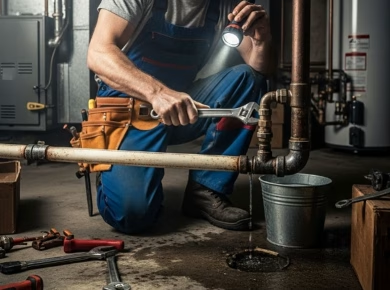As an avid crafter, I’ve always been on the lookout for tools that enhance my crafting projects, matching the fervor of my creative needs. The advent of the knitting machine has revolutionized the way I approach my work, providing efficiency and intricacy that’s a leap beyond traditional hand knitting. After extensive research and self-testing, I’m excited to share the nuances that matter when selecting a knitting machine tailored to your projects and knitting aspirations.
Faced with the choice between a punchcard and an electronic knitting machine, I consider the type of patterns I envision creating. If my heart is set on intricate, custom designs, I appreciate the versatility a computer-programmed machine offers. Conversely, when straightforward, repetitive designs call to me, a punchcard knitting machine seems to be a perfect fit. Size is another critical factor; selecting a machine that accommodates the breadth of my projects is paramount, yet it must align with my workspace and skill level. As for yarn compatibility, it’s imperative to ensure that the machine can handle my preferred yarn weight and thickness, to avoid any unnecessary snags or damage.
Join me as I delve into each aspect that will guide you toward making an informed choice, ensuring your knitting machine is a worthy companion for all your future crafting projects.
Understanding Different Types of Knitting Machines
As I delve deeper into the world of knitting, I’ve come to appreciate the nuanced differences between punchcard knitting machines and electronic knitting machines. These distinctions are crucial for aligning a machine with my knitting projects and creative aspirations.
Punchcard machines have a certain charm, channeling knitting traditions with their sturdy, tangible programming cards. Each card, punctuated with holes, sets the stage for exquisite, patterned fabrics. This mechanical ancestor is dependable, offering consistency in repeated designs – a gateway to knitting with a historical touch.
In contrast, the electronic knitting machine speaks the language of modernity, responding swiftly to digital prompts and entrancing me with their vast pattern libraries. The promise of virtually limitless creativity awaits as I command intricate designs and delicate details with just a few keystrokes.

Understanding these options was pivotal to my journey, so I crafted a comparative table to visualize their features at a glance:
| Punchcard Knitting Machine | Electronic Knitting Machine | |
|---|---|---|
| Pattern Input | Pre-punched cards | Computerized programming |
| Design Flexibility | Limited to card designs | Highly customizable patterns |
| Learning Curve | Moderate, great for mastering basics | Steeper, rewards with advanced features |
| Project Suitability | Ideal for repetitive patterns | Best for unique, elaborate creations |
A discerning decision now rests upon my shoulders, as I weigh the charms of punchcards against the allure of digital design. Balancing the tactile pleasure of manual patterning with the thrill of endless electronic possibilities will dictate my next move in the enthralling world of machine knitting.
Choosing the Right Knitting Machine Size and Yarn Compatibility
When it comes to knitting on a machine, the size of the unit and the type of yarn it can accommodate are two of the most crucial factors in your decision-making process. The machine size dictates how large a project you can tackle and is indicative of the sheer breadth of your creative capabilities—be it chic scarves or extensive blankets. Simultaneously, understanding yarn compatibility ensures that every stitch reflects the quality and consistency you desire in your work.
Evaluating Machine Size for Your Projects
The enormity of a task like knitting an afghan or an adult sweater demands a machine that can rise to the occasion. Larger knitting machines, with their expansive needle beds, are robust partners for such large knitting projects, but they also require an equally large commitment to space and handling. Mindful deliberation of machine size is, therefore, essential to harmonize your ambition with the logistics of crafting and storage space. Whether for personal use or commercial endeavors, the correct machine size profoundly influences the scope and feasibility of your knitting vision.

Selecting a Machine Based on Yarn Types
Meanwhile, yarn compatibility offers another layer of specification. It isn’t simply enough to have a machine that knits; it must knit the yarn weight, yarn types, and yarn thickness you intend to use. A slender lace-weight yarn, for instance, requires a different gauge than chunky, heavyweight yarns. Common gauges for knitting machines include standard, mid, and bulky, each designed to handle specific yarn weights. Ignoring the gauge is a folly that can result in frustrated efforts and damaged materials, a scenario I’m keen to help you avoid. By aligning machine capabilities with the yarn types you use, you set the stage for seamless creation and longevity of your machine and products.
Key Features and Accessories to Consider in a Knitting Machine
When it comes to elevating my knitting game to new heights, understanding the variety of Knitting Machine Features and Machine Accessories available is crucial. Not only do these features define the capability of the machine, but they also contribute significantly to Knitting Efficiency, making the creative process smoother and more enjoyable.
Some of the key features that grab my attention include:
- Automatic tension control for consistent stitch quality
- A diverse range of stitch options for expansive design possibilities
- The invaluable addition of a ribbing attachment to expand the repertoire of knit patterns
Alongside these features, I’ve learned that choosing the right accessories can dramatically impact the overall knitting experience:
- Needle inserts to accommodate various yarn weights, ensuring versatility in my knitting projects
- Lace carriages to add intricate textures and fine details to my work
- Punchcards for those who appreciate the ease and reliability of pattern-making

Having these features and accessories not only empowers me to tackle complex projects with ease, but it also opens up new avenues for creative exploration. To provide a clear insight into how different machines cater to these requirements, I’ve put together a comparison of common machine features and their corresponding accessories:
| Feature | Accessories | Impact on Efficiency |
|---|---|---|
| Automatic Tension Control | Tension Dials and Weights | Consistent fabric tension, fewer manual adjustments |
| Variety of Stitches | Multipurpose Carriages | Enables complex patterns without manual intervention |
| Ribbing Attachment | Ribbing Plates and Needles | Allows for seamless transition to ribbed patterns |
| Needle Insert Compatibility | Interchangeable Needles | Adapts to various yarn sizes, improves project versatility |
| Lace Carriage | Lace Punchcards/Programs | Simplifies the creation of lace patterns |
In conclusion, the synergy between a knitting machine’s features and its accessories plays a monumental role in enhancing knitting efficiency. By ensuring these elements are aligned with my knitting goals, I am equipped to delve into projects with confidence, knowing that my toolset fully supports my creative vision.
Knitting Machine Reviews and Recommendations
My journey through the landscape of knitting machine reviews has been comprehensive, revealing key insights into models that boost crafting efficiency. Each machine beckons with its strengths, foreshadowing a unique impact on my creative endeavors.
With the Addi Express King Size, I’m elated by its swift knitting capabilities, vital for progressing with substantial projects in a timely manner. I’ve been cautious with the delicate row counter and gear shaft, treating it with the precision it demands for optimal performance.
The Umootek Knitting Machine, on the other hand, has appealed to me due to its approachability in both cost and beginner-friendly aspects. I remain vigilant to avert missed stitches and maintain its steady rhythm.
Furthermore, the SENTRO Knitting Machine has earned my admiration for its velocity in knitting and the adaptable yarn density, enhancing the versatility of my crafts. Yet, I ponder over possible longevity concerns and its fixed position without a clamping mechanism.
The BUAOB Knitting Machine emerged as a contender due to its simplicity in operation and the allure of its dual knitting modes, despite some reservations against its less sturdy needle design in comparison to its metal counterparts.
Last but certainly not least, the BZVV Knitting Machine struck me with its solid construction and ease of use, which far overshadows the infrequent hiccup of an ignored row count during my knitting sessions.
| Machine Model | Key Features | Pros | Cons |
|---|---|---|---|
| Addi Express King Size | Swift knitting, secure operation | Quick project completion | Delicate row counter and gear shaft |
| Umootek Knitting Machine | Affordable, beginner-friendly | Cost-effective, ideal for new knitters | Needs monitoring for stitch consistency |
| SENTRO Knitting Machine | Fast knitting, adjustable yarn density | Speedy and versatile craftsmanship | Questionable durability, lacking clamping system |
| BUAOB Knitting Machine | Easy to use, dual modes | User-friendly for varied projects | Potentially less durable needle construction |
| BZVV Knitting Machine | High-quality build, user-oriented | Solid and reliable for long-term use | Sometimes skips count on row counter |
I’ve found these detailed analyses to be essential as I weigh the unique attributes of each knitting machine. It is clear that considerations for crafting efficiency and project requirements are at the forefront of selecting the ideal equipment for my knitting endeavors.
Practical Insights on Selecting a Knitting Machine
As someone passionate about knitting, I’ve come to realize that choosing the right knitting machine is not just about picking any model off the shelf; it’s a nuanced decision influenced by my unique knitting preferences, the textures I want to create, and the yarns I wish to employ. The question at hand is not just “Which knitting machine should I buy?” but “Which machine will harmoniously align with the visions I have for my knitting projects?”
From my experience, the Yarn Gauge holds substantial weight in this decision. Opting for a machine that doesn’t accommodate the yarn thickness I frequently use would be like trying to fit a square peg into a round hole—you’ll end up with a tool that doesn’t serve its purpose. Here’s where the decision matrix gets personal. Am I drawn toward the allure of crafting cozy, chunky blankets? Or is my heart set on delicate, airy shawls? My affinity for either of these items guides me towards a bulky gauge or a standard gauge machine, respectively.
- For bulky, cabled knits: A heavy-duty machine tailored for thick yarns.
- For fine, intricate patterns: A standard gauge machine with finer needles.
- For hand-knit textures, a versatile mid-gauge machine bridges the gap between the two extremes.
A key consideration is the availability of modern machines and their parts. Rather than settling on a used or discontinued model that could leave me stranded without support, I lean towards current, widely-supported machines. It’s not only about what the machine can do today—it’s about ensuring it will continue to serve me well into the future.
Seeking out machine knitting clubs and educational lessons from reputable dealers has been invaluable. There, I have gleaned insights from seasoned knitters and tried various machines hands-on, solidifying my understanding of what I require from my investment.
Ultimately, becoming well-acquainted with the knitting machines available in the market helps streamline the selection process. So whether I’m crafting an intricate lace border or a bold statement sweater, I’m confident that the choice I make will be a cornerstone for my crafting aspirations, helping me weave my creativity seamlessly into each stitch.
Knitting Machine Guide – Insights for 2023
As we usher in the new year, my focus sharpens on the evolving landscape of knitting machines. With Crafting Updates at the forefront, I am keenly observing the latest in Electric Knitting Machines and the enduring charm of Hand Crank Knitting Machines. The goal is to ascertain which machine aligns seamlessly with my creative vision and practical needs.
To my fellow crafters navigating this vibrant world of yarns and stitches: let’s delve into the qualities that set apart the machines of 2023. The electric models lure us with their promise of efficiency and precision, a boon for those intricate, pattern-rich projects. Conversely, the tactile feedback of a hand crank machine offers a more grounded and hands-on approach, very much in line with traditional knitting.
| Type | Best for | User-Friendliness | Design Complexity | Price Range |
|---|---|---|---|---|
| Electric Knitting Machine | Sophisticated patterns | High | Complex | $200 – $2500 |
| Hand Crank Knitting Machine | Simple projects, hands-on experience | Moderate | Basic to Moderate | $50 – $200 |
| Circular Knitting Machine | Beanies, socks, small tubes | High | Basic | $30 – $150 |
| Flat Knitting Machine | Scarves, sweaters, large flat pieces | Varies | Basic to Advanced | $100 – $3000 |
In contemplating the right choice, I consider the type of projects I am most passionate about. Do I yearn for the rhythmic click of needles shaping a seamless beanie, or do I envision sprawling scarves with intricate color work? The decision also hinges on the design complexity I crave—am I content with simple, straight patterns, or do I aspire to master the elaborate intricacies afforded by electronic advancements? Budget, as ever, remains a pragmatic compass, guiding me towards a machine that balances aspiration with affordability.
Conclusion
Embarking on the journey of investing in the right knitting machine is one laden with anticipation and keen foresight. As an avid crafter, aligning the features, yarn compatibility, and type of machine with my crafting goals has been pivotal in making a selection that promises long-term success. A careful investment in a knitting machine is not merely a purchase—it’s a step towards expanding my creative repertoire and maintaining a steady pace of high-quality, intricate knitting projects that could otherwise be unattainable.
Investing in the Right Machine for Long-Term Crafting Success
My machine investment hinges on the recognition that this tool is an essential partner in my crafting endeavors. The correct choice propels my capabilities forward, allowing me to tackle complex designs with ease and grace. It is an assurance of meeting, perhaps even exceeding, my ambitious crafting aspirations. As I nurture my skills, the knitting machine that I integrate into my creative life now becomes a cornerstone for myriad projects that beam with professional finesse and personal flair.
Maintaining Your Knitting Machine for Optimal Performance
Longevity and performance optimization of my knitting machine are underpinned by diligent machine maintenance. Crafting longevity does not rest on the machine’s initial quality alone but equally on how well I preserve its functionality. Regular cleaning, mindful storage, and respecting the manufacturer’s care guidelines serve as the backbone for a reliable knitting experience. Cognizant of wear and potential tension issues, I stand ready to remedy any mechanical nuances posthaste, ensuring my machine sustains its role as my trusted implement in the pursuit of knitting excellence.
FAQ
What should I consider when buying a knitting machine for my crafting projects?
When buying a knitting machine, consider the type (punchcard or electronic), the size of the projects you plan to undertake, the yarn types you’ll use, and the machine’s features and accessories that can aid in your creative needs.
What are the differences between punchcard and electronic knitting machines?
Punchcard knitting machines use pre-printed cards to create patterns, which is great for repetitive designs. Electronic knitting machines are programmed via a computer, offering greater versatility and the ability to create complex patterns for a variety of knitting projects.
How do I choose the right machine size for my knitting projects?
The right machine size for your projects will depend on the scope of your work. Large knitting projects like sweaters or blankets will require a machine that can accommodate a wider piece of fabric, while smaller projects may be done on compact machines.
Why is yarn compatibility important in a knitting machine?
Yarn compatibility is critical because not all knitting machines handle all yarn weights or thicknesses. It’s important to select a machine based on the types of yarn you intend to use, from yarn weight to yarn thickness, to ensure the best results and avoid damage to your machine.
What features and accessories should I look for in a knitting machine?
Look for features that will enhance your knitting efficiency, such as automatic tension control, various stitch types, and the possibility of attachments like a ribbing accessory. Consider machine accessories that are compatible with the types of projects you’ll be working on.
Can you provide some knitting machine reviews or recommendations?
Yes, the Addi Express King Size, Umootek Knitting Machine, SENTRO Knitting Machine, BUAOB Knitting Machine, and BZVV Knitting Machine are among the highly recommended machines, each with its own unique features that could suit different aspects of crafting efficiency.
How should I select a knitting machine based on my yarn gauge and knitting preferences?
Choose a machine that corresponds to the yarn gauge you frequently use. If you prefer to knit with fine yarns, a standard gauge machine might be best, while a bulky gauge machine is better for thick yarns. Your knitting preferences, such as the types of patterns you wish to create, should also guide your selection.
What should I consider in a knitting machine for crafting updates in 2023?
For the latest crafting updates in 2023, consider whether you want an electric knitting machine for more automated pattern creation, or a hand crank machine for control and involvement in the knitting process. Also, keep in mind whether your projects are mostly flat or tubular, which will determine if you need a flat or circular machine.
What are the long-term benefits of investing in the right knitting machine?
Investing in the right machine aligns with your crafting goals and ensures long-term success. A machine that matches your preferences and project requirements will be a valuable asset that grows with your skills and provides continuous, high-quality results.
How do I maintain my knitting machine for optimal performance?
For the best performance optimization and crafting longevity, regularly clean your knitting machine, store it properly, and follow the manufacturer’s care instructions. Keeping an eye out for common issues like needle wear or tension problems can also help you maintain the machine in excellent condition.





